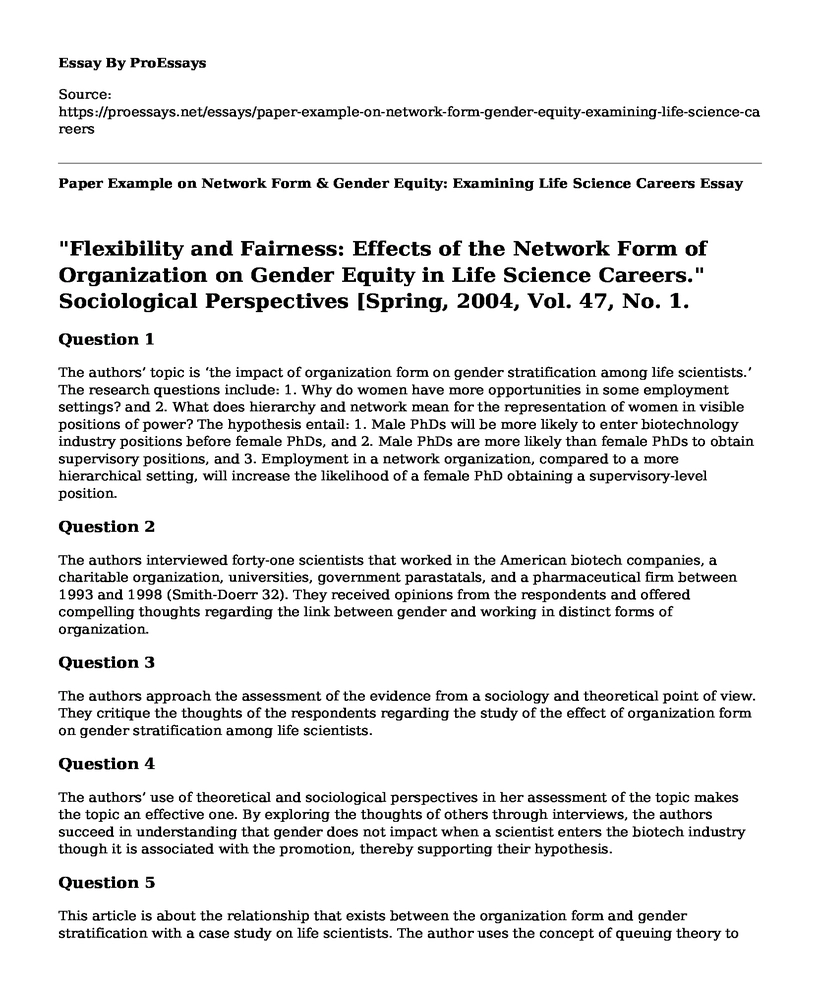"Flexibility and Fairness: Effects of the Network Form of Organization on Gender Equity in Life Science Careers." Sociological Perspectives [Spring, 2004, Vol. 47, No. 1.
Question 1
The authors’ topic is ‘the impact of organization form on gender stratification among life scientists.’ The research questions include: 1. Why do women have more opportunities in some employment settings? and 2. What does hierarchy and network mean for the representation of women in visible positions of power? The hypothesis entail: 1. Male PhDs will be more likely to enter biotechnology industry positions before female PhDs, and 2. Male PhDs are more likely than female PhDs to obtain supervisory positions, and 3. Employment in a network organization, compared to a more hierarchical setting, will increase the likelihood of a female PhD obtaining a supervisory-level position.
Question 2
The authors interviewed forty-one scientists that worked in the American biotech companies, a charitable organization, universities, government parastatals, and a pharmaceutical firm between 1993 and 1998 (Smith-Doerr 32). They received opinions from the respondents and offered compelling thoughts regarding the link between gender and working in distinct forms of organization.
Question 3
The authors approach the assessment of the evidence from a sociology and theoretical point of view. They critique the thoughts of the respondents regarding the study of the effect of organization form on gender stratification among life scientists.
Question 4
The authors’ use of theoretical and sociological perspectives in her assessment of the topic makes the topic an effective one. By exploring the thoughts of others through interviews, the authors succeed in understanding that gender does not impact when a scientist enters the biotech industry though it is associated with the promotion, thereby supporting their hypothesis.
Question 5
This article is about the relationship that exists between the organization form and gender stratification with a case study on life scientists. The author uses the concept of queuing theory to explore the issue of gender inequality in the labor market. Hence, the information offered is relevant to the course readings.
"Women Inventors in Context: Disparities in Patenting across Academia and Industry."
Question 1
The authors’ topic is ‘disparities in parenting across academia and industry.’ The research questions include: 1. Is hierarchy (and its more formal rules) or the network form better for women’s productivity in science? The hypothesis include: 1. Sex disparities in scientists’ patenting behavior will be less in science-based network firms than in other organizational settings.
Question 2
The authors utilize the data from online databases to gather information for their article (Whittington et al. 201). They assess and critique the information in these studies and offer their compelling thoughts regarding the topic of inequalities in parenting across academia and industry.
Question 3
The authors approach the assessment of her evidence from a theoretical standpoint. They explored how variation in organizational logic impacts the differences in sex in scientists’ commercial productivity as gauged by parenting.
Question 4
The authors’ use of theoretical perspectives in her examination of the topic makes it effective. By using the information from the online databases, the authors succeed in disclosing how the organization of the work of scientists might impact the inequalities of both genders in science and their repercussions of these findings for future work (Whittington et al. 201).
Question 5
The information in this article highlights how the variation in the logic of the organization impacts the sex differences in commercial productivity of the scientists as gauged by patenting. The author utilizes the concept of inequality to explain the productivity differences between women and men in science seem to focus on the academic sector and personal level. Thus, the information provided is relevant to the course readings.
Works Cited
Smith-Doerr, Laurel. "Flexibility and fairness: Effects of the network form of organization on gender equity in life science careers." Sociological Perspectives 47.1 (2004): 25-54.
Whittington, Kjersten Bunker, and Laurel Smith-Doerr. "Women inventors in context: Disparities in patenting across academia and industry." Gender & Society 22.2 (2008): 194-218.
Cite this page
Paper Example on Network Form & Gender Equity: Examining Life Science Careers. (2023, Aug 13). Retrieved from https://proessays.net/essays/paper-example-on-network-form-gender-equity-examining-life-science-careers
If you are the original author of this essay and no longer wish to have it published on the ProEssays website, please click below to request its removal:
- Healthcare Paper Example: Project in Organization Leadership
- Pros and Cons of Leadership Models and Grids Essay
- Paper Example on Project Management in the Dutch Market
- Essay Example on US Intelligence Community: Safeguarding National Security
- Research Paper on Leadership: The Key to Lasting Success in Institutions
- Research Paper on Religion, Terrorism & Extremism: Linked in Unpopular Beliefs
- Research Paper on Gambling in Sports: Study of Exposure & Intention







